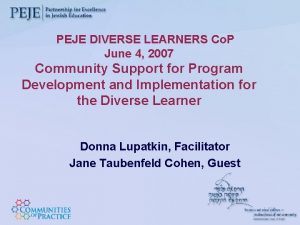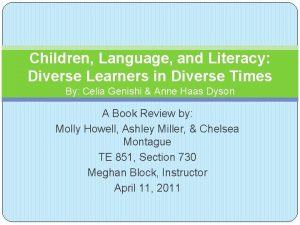Resources to Accompany PEJE Diverse Learners Co P












- Slides: 12

Resources to Accompany PEJE Diverse Learners Co. P: Integrating Occupational Therapy Services into a Day School Setting Facilitator: Donna Lupatkin Guests: Sue Schweber, Ilene Greenwald, Marcie Lipsey Gateways: Access to Jewish Education Boston, MA Date: January 14, 2008

How do I know if my school-age child needs occupational therapy services? 1. Difficulty focusing attention or over-focused and unable to shift to the next task. 2. Low muscle tone; tends to lean on arms or slumps at desk. 3. Needs more practice than other children to learn new skills. 4. Reverses letters such as b and d; can’t space letters on the lines. 5. Breaks pencils frequently or writes with heavy pressure. 6. Does not enjoy jumping, swings or having feet off the ground. 7. Dislikes handwriting, tires quickly during written class work. 8. Difficulty paying attention or following instructions. 9. Overly active, unable to slow down. 10. Poor self-esteem, lack of confidence. 11. Dislikes swimming, bathing, hugs, and/or hair cuts 12. Over-reacts to touch, taste, sounds, or odors 13. Avoids physical education or sports activities. 14. Finds it difficult to make friends with children of the same age, prefers to play with adults or younger children rather than peers. 15. Difficulty following several step instructions for motor tasks. If your child is experiencing 3 or more problems on this checklist, occupational therapy intervention may be helpful.

ATTENTION TEACHERS!!! Do any of your students have problems learning? Does s/he exhibit a number of the following behaviors? • Falls off chair • Knocks things off desk • Generally disorganized • Clumsy, awkward, uncoordinated movements • Distractibility • Short attention span • Intolerance to stress/easily frustrated • Daydreaming or inattentiveness (hearing is adequate) • Irritability • Frequent mood changes • Aggressive behavior - bumps or pushes others • Aversion to touch • Avoidance of messy activities • Hyperactivity - in constant motion without purpose • Hypoactivity - slow moving • Speech and language problems • Poor fine motor coordination • Normal intelligence but trouble learning to read or do mathematics If so, they may be experiencing Sensory Integrative Dysfunction and be at risk for learning problems.

What is a sensory diet? 1. PUT SOMETHING IN YOUR MOUTH: • eat hard candy (sugarless if you want • eat crunchy food: pretzels, popcorn, nuts, apples • eat chewy food: gum (1 or more pieces), raisins, bagels, chunks of cheese • eat sour food: pickles, sour candy • eat sweet food: fruit or candy • drink from a straw: use an “exercise bottle” to drink liquids such as a milkshake, a “Slurpie” (partially thaw a frozen drink), or other drinks • eat a combination such as trail mix (crunchy, chewy, sweet), Starburst (chewy, sweet, and tart), or chips dipped into salsa (crunchy and spicy) • use green rubber tubing • take slow deep breaths 2. MOVE: (try moving before you need to concentrate - ex: homework) • do isometrics (push arms on a wall or push hands together) • walk quickly (in school or take the dog for a walk) • run up and down steps • do an errand for a teacher • shake head quickly • roll neck slowly in circular motion • jump up and down or try to jump to touch a door frame • play sports - basketball, swimming, baseball, frisbee, etc. • do aerobics with a group or at home to music • dance • use a therapy ball

3. TOUCH: • try holding and “fidgeting” with a Koosh Ball, paper clips, rubber bands, straw, jewelry, or clay • rub gently or vigorously on your skin or clothing • take a cool shower or warm bath • wash your face with a cold or hot wash cloth • pet or play with an animal • hold or lean up against stuffed animal or large pillows 4. LOOK: • put bright lights on in room if you are in low speed • dim the lights if you are in high speed • clear off the table you are working on if it distracts you • watch fish in an aquarium • read a hook or look at magazine 5. LISTEN: • listen to classical type music (even, slow beat) • listen to hard rock type music (loud bass, uneven beat) • use a personal cassette player if the music bothers someone else • avoid loud, noisy places if you are in high speed or if it bothers you when you are trying to concentrate A-46 “How does your engine run? ” © 1994, Therapy Works, Inc. This page may be reproduced for instructional use.

“HEAVY WORK” ACTIVITIES FOR CLASSROOMS • recess time: climbing or crossing the monkey bars, the rings, or other climbing structures • stretching muscles or singing baseball’s 7 th inning stretch song, “Take Me Out to the Ball game” • pushing on walls while standing in line at school • carrying heavy box to the office or on other school errands • pulling a wagon or pushing a weighted grocery cart in preschool • pulling on a bike inner tube (store in backpack to keep handy whenever needed) doing chair push-ups (Place arms on either side of the chair. Scoot bottom away from the back of the chair. Try to straighten arms, lifting bottom off of the chair. ) • doing table push-ups (Stand next to a table. Place hands on the table and push up so feet lift off the floor. ) • sweeping or mopping the gymnasium floor or hallway floor with a big broom washing cafeteria tables carrying milk tray or pushing a cart filled with lunch boxes to the cafeteria erasing the chalkboards moving mats, equipment, or school furniture putting chairs on top of desks to prepare for floor cleaning at the end of the school day

Building upper body strength is crucial to handwriting. Simple variations in body position can go a long way.


OT’s Top Ten List for Pre. Handwriting Exercises 1. Mickey Mouse Ears - Place fists next to ears, squeeze, fingers open and close, 10 -15 times. 2. Desk Push Ups - Hands flat on desks, thumbs and pointer tips facing each other (creating a triangle), bend elbows, nose into triangle created between hands, then up 10 -15 times. 3. Windshield Wipers - Arms above head, cross straight arms 10 times then put bottom arm over top hand do 10 more. 4. Scissor Cuts - Same as above only arms are pointed straight down with palms up. 5. Shoulder Shrugs - Called the “I Don’t Knows” palms up shoulder shrugs towards ears, release, 10 -15 times. 6. Throw Aways - Elbows bent, fisted hands in front of shoulders, extend arms in a throwing motion, 1015 times. 7. Door Knob Turns - Arms in front of you, elbows slightly bent, four fingers right next to each other, thumbs open, turn both hands toward thumbs at wrist, turn and return to mid position (not towards little finger), 10 -15 times. 8. Good Morning America - Hands hold opposite elbows, lift in a single motion over the head, return to waist and repeat, 10 -15 times. 9. Finger Opposition - Hold fingers next to ears, have child touch thumb to each finger (i. e. pointer, middle, ring, pinkie) and back again, 10 -15 times. 10. Butterflies - Hold arms straight in front of body, make an X with thumbs, palms facing out, make small circles 10 times to the right, then 10 times to the left. Other Ideas: Donkey Kicks, Wheelbarrow Walks, Army Crawls, Itsy Bitsy Spider, Finger Shadows, Where Is Thumbkins, Finger Flicks. *Contributed by Tere Bowen-Irish, QTR/L ©HENRYOTSERVICES, INC. 1998 • YOUNGTOWN, AZ 85363 • 602 -938 -5813 • 888. 371 -1204

PROGRAMS THAT WE USE IN GATEWAYS • • • HANDWRITING IT WRITE FIRST STROKES LOOPS AND GROUPS HANDWRITING WITHOUT TEARS CALLIROBICS • • SENSORY REGULATION/GETTING READY TO LEARN HOW DOES YOUR ENGINE RUN-THE ALERT PROGRAM TAKE FIVE PROGRAM BRAIN GYM WILBARGER BRUSHING PROTOCOL TOOL CHEST PROGRAM FINE MOTOR OLYMPICS • • OTHER FAVORITE REFERENCES PARENTS GUIDE TO UNDERSTANDING SENSORY INTEGRATION, by Sensory Integration International THE OUT OF SYNC CHILD, by Carol Stock Kranowitz THE OUT OF SYNC CHILD HAS FUN by Carol Stock Kranowitz RAISING A SENSORY SMART CHILD by Biel and Peske THE RELATIONSHIP OF LEARNING PROBLEMS AND CLASSROOM PERFORMANCE TO SENSORY INTEGRATION –author unknown OUT OF THE MOUTH OF BABES by Frick, Oetter, and Richter •

Contact our Guests • Sue Schweber sue@jgateways. org • Ilene Greenwald ilene@jgateways. org • Marcie Lipsey marcie@jgateways. org

v. Bulletin • To log in to the PEJE Communities of Practice Discussion Boards on v. Bulletin Forum: • Go to http: //community. peje. org • Enter your User Name. Your User Name is your first name, followed by a space, then your last name (Example: John Smith). • Enter your default Password and click Log in. (Your default password has been sent to you in a separate email. )
 Technology for diverse learners
Technology for diverse learners Diversity among protoctista
Diversity among protoctista Accompany
Accompany Things that accompany salvation
Things that accompany salvation Accompany chapter 1
Accompany chapter 1 Supratrochlear lymph node
Supratrochlear lymph node Operations transformation process
Operations transformation process Differentiate fixed resources and variable resources
Differentiate fixed resources and variable resources Renewable resources vs nonrenewable resources
Renewable resources vs nonrenewable resources Remedial teaching activities
Remedial teaching activities Reading strategies for english language learners
Reading strategies for english language learners Involuntary attention definition
Involuntary attention definition When is cognitivism beneficial for learners
When is cognitivism beneficial for learners






















